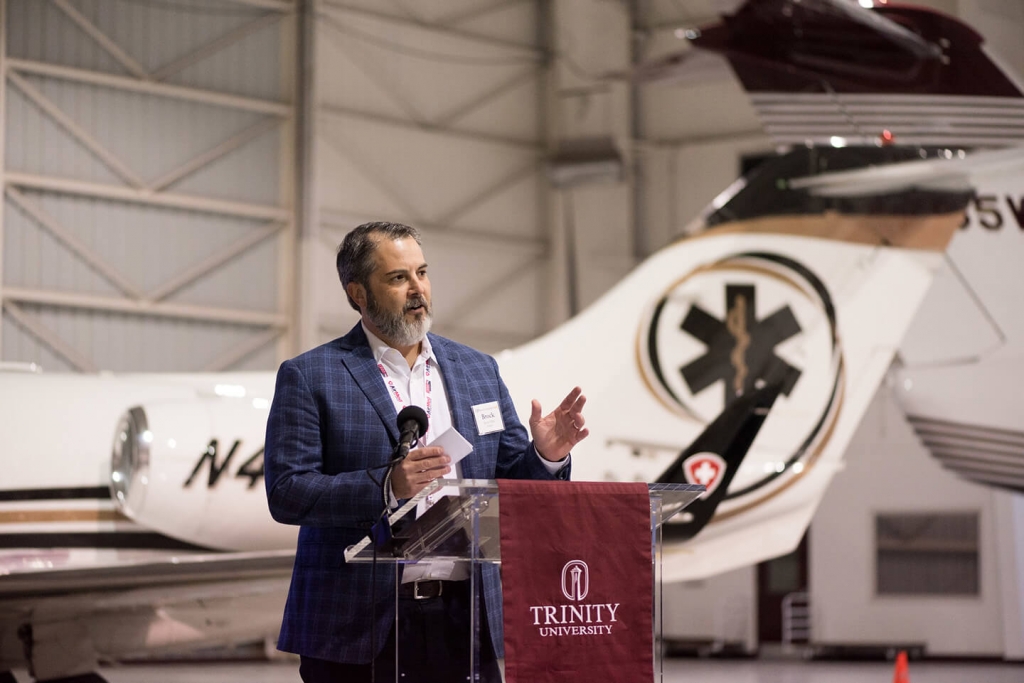Marketing is the foundation for success
Home to more than 2,500 students, Trinity University overlooks such iconic locations as the Alamo in downtown San Antonio. The book on the liberal arts and sciences college is that Trinity is guided by a mission and set of values with student experience at the core. Over the course of the past 18-plus months, working within a higher education landscape scrambling for enrollment engagements in a pandemic-defined environment, the marketing emphasis remains grounded in research.
Whether quantitative or qualitative, Trinity’s segmentation was precise and strategic, and the mediums aligned with reaching the intended audiences. “Campaigns that have been highly successful were predominantly digital, where we could assess and adjust spend, messaging and targeting throughout the campaign,” says Michelle Bartonico, the university’s Senior Strategist and Project Manager.

It is no secret that COVID-19 sent higher education into a tailspin, with institutions around the country citing the global pandemic as the source for budget woes, changes in student demands and employee morale. More than any other time, the customer acquisition game is expensive, lengthy and competitive, with only a select group of institutions carving out a niche or differentiation for their brand. This means customers—both prospective and current students—are overwhelmed with choice and determined to seek perceived value.
According to Bartonico, a silver lining is marketing’s ability to present research and assess the strengths, threats and opportunities within a marketplace. “Marketing shouldn’t be standalone. The discipline is stronger when working alongside other subject matter experts on campus ranging from financial aid and enrollment management to student life. More than ever, marketing can help inform product, positioning and brand approach. It can help serve as an objective voice measuring website metrics, advertising performance, and conducting focus groups.”
Tough environment or not, marketing affords higher education marketers an opportunity to think differently, to practice, as Bartonico says, what they teach their students to practice — innovate, be bold, define and live their values.
The reason the whole experience works is that Trinity University understood the value of marketing earlier than most—transforming a Communication and Public Relations office into essentially a full-scale in-house agency eight years ago. The university had a vision that marketing was a revenue generating unit rather than an expense center, strategically partnering with divisions such as enrollment management, alumni relations and development. And like any strategic, successful marketing initiative, the most essential piece of this support came from the top—the president’s office.

“When an organization’s relationship with its customers—namely prospective and current students—becomes transactional, price and value are at the forefront,” Bartonico says. “And brand is inseparable from the perception of value. With the marketplace offering accelerator programs, e.g., general assembly, direct pipelines to well-known employers like Google and a variety of delivery methods, students have moved along the continuum where institutions are viewed more and more by students as transactional rather than transformational.”
As part of its marketing approach, social media platforms are foundational to engaging authentically and continuously with Trinity students—both prospective and current. For example, its Instagram account currently is its dominant platform right now, and continues to grow due in part to quality content and ad campaigns. The Trinity marketing team also continuously utilizes direct marketing to drive awareness to their social accounts, including creating cards with URLs and placing them around campus.
“Marketing is the one area of a campus that should be able to have a line of sight across all silos—connecting ideas, content, and narrative on behalf of moving the brand forward.”
— Michelle Bartonico, Senior Strategist & Project Manager, Trinity University
“It’s all about the customer experience and journey mapping,” Bartonico says. “Marketing is the one area of a campus that should be able to have a line of sight across all silos—connecting ideas, content, and narrative on behalf of moving the brand forward.”

The story is the story
In what is one of the most interesting—and challenging—times to be a part of higher education, Teresa Mannix believes how a university chooses to tell its story is critical. For Mannix, Associate Dean, and Chief Marketing and Communications Officer at Georgetown University’s McDonough School of Business, that means focusing on the qualities that make your school different from the scores of others out there fighting for attention.
In the case of Georgetown University’s McDonough School of Business, how is the ROI of its degrees better? How do (and can) prospective students fit into the school’s community and culture? “Beyond admissions, it’s important for us to engage with potential donors and corporate sponsors, our alumni community, organizations that may want to partner with our faculty on research or experiential class projects, or talented individuals who may want to join our faculty or staff,” Mannix says.

Are their programs working? Mannix reflects on a conversation she had recently with a colleague who had been promoted from another area of the school to the Dean’s Office. One of the first things she said was, “I am surprised to see all of the projects your team is working on.” While from a distance her colleague may have received one-off requests, when she took a deeper dive into the central function of the Office of Marketing and Communications, the reality of what it does jumped out at her.
“The truth is that we are strategic partners, often behind the scenes, for our leadership across most of the school’s initiatives,” Mannix says. “If you look at the evolution of marketing within higher education, it’s fairly new as a strategic function. When I started my career at another university, marketing was something that just resided in admissions. Our office was responsible for media relations and publications. Even early on, websites were more like directories of information for internal audiences, rather than an external marketing tool for an institution.”
Today, Mannix says the best way a school can show its commitment to marketing is to view it as a strategic function that reports to the unit’s chief executive (similar to what Trinity does)—whether that’s a president, provost or dean. The university’s overall strategy—and marketing strategy—should be aligned. The teams must work closely together in order to ultimately succeed.
At Georgetown’s McDonough School of Business, everyone has a clear alignment between the dean’s strategic plan and how its Office of Marketing and Communications fits into that plan. They also work closely with their colleagues in related marketing functions for the admissions teams, Corporate Executive Education department and faculty-led institutes to advance the school-wide marketing goals.

“Regardless of the strategy or tactic, understanding our audience is at the foundation of everything we do,” Mannix says. “The first question we usually ask is to define their audience. As demographics shift and the world changes around us, it’s our job to ensure we define our stakeholders and learn how to best communicate our messages to them. There are so many different ways to communicate, and we spend a lot of time working to match the medium to the message.”
“Regardless of the strategy or tactic, understanding our audience is at the foundation of everything we do.”
— Teresa Mannix, Associate Dean/Chief Marketing & Communications Officer, Georgetown University’s McDonough School of Business
The success of Georgetown McDonough’s marketing campaigns can be seen in a recent advertising campaign aimed at a regional audience to support its branding efforts around the dean’s strategic initiatives. Partnering with the local edition of a national news outlet, the Georgetown McDonough team distributed articles about each initiative. Among its performance metrics was that the average time on the page for our articles was more than the average time spent on the page for the publication’s actual articles.
“We were excited to see that people were reading the articles and, of course, clicking through to our website from the embedded links,” Mannix says. “The reason it was so successful is that we didn’t make a hard sell. We understood our audience and crafted expert, research-based advice from faculty that business executives could use in their day-to-day work.”
Grounded in research and targeted with the right tools, at the right time, are the keys today’s higher ed marketers will continue to utilize in a world that is defined by change.